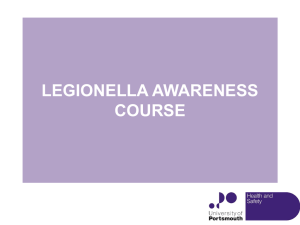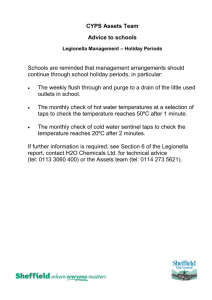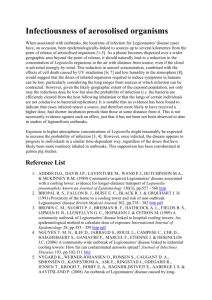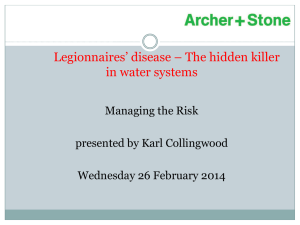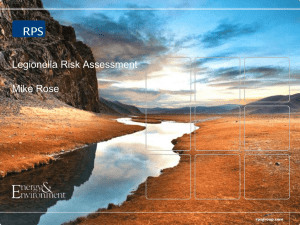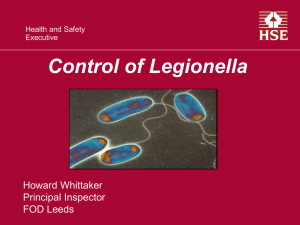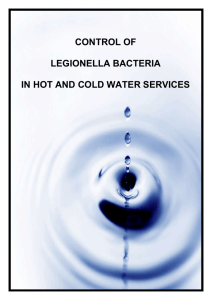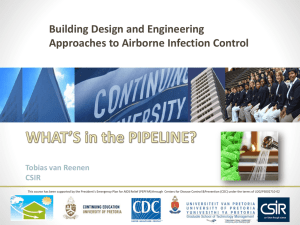AMERICAN SOCIETY OF HEATING, REFRIGERATING, AND AIR
advertisement
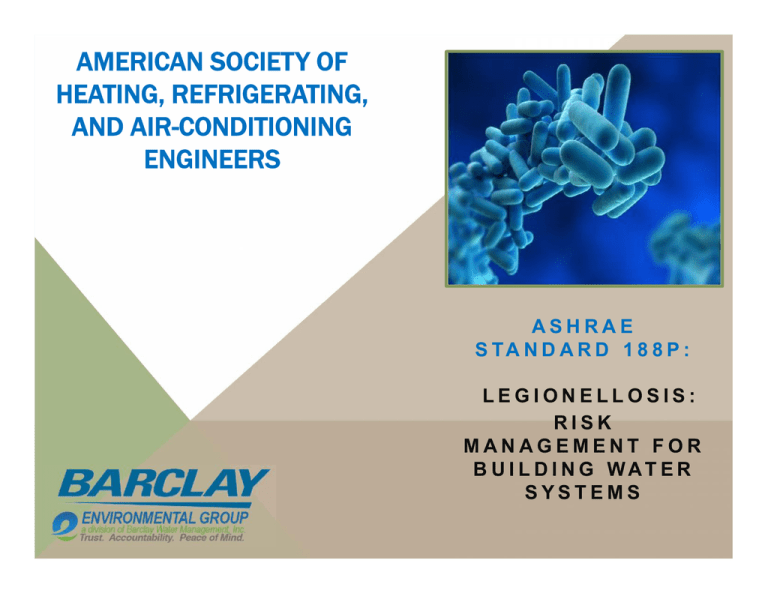
AMERICAN SOCIETY OF HEATING, REFRIGERATING, AND AIR-CONDITIONING ENGINEERS ASHRAE S TA N D A R D 1 8 8 P : LEGIONELLOSIS: RISK MANAGEMENT FOR B U I L D I N G WAT E R SYSTEMS Technical Consensus about what must be done to prevent Legionellosis associated with building water systems. The new standard will require that facility managers implement stronger safeguards through pro-active risk assessment and risk management practices. American Society of Heating, Refrigerating and Air Conditioning Engineers WHAT IS AN ASHRAE STANDARD? American Society of Heating, Refrigerating and Air Conditioning Engineers ASHRAE publishes standards and guidelines relating to HVAC systems. Standards are often referenced in building codes, and considered useful standards by consulting engineers, mechanical contractors, architects, government agencies. These are legally unenforceable, but commonly accepted standards in the industry. DIFFERENCE BETWEEN POLICIES, STANDARDS, GUIDELINES AND PROCEDURES? Policies ASHRAE 188P Standards (specific mandatory controls) Guidelines (recommendations / best practice) Procedures (step by step instructions) WHAT DOES THIS STANDARD MEAN FOR FACILITIES? ASHRAE 188P standard applies to buildings with any one of the following: Multiple rooms served by centralized water heater Ten or more stories Is a healthcare facility where patient stays exceed 24 hours Immuno-compromised individuals Cooling towers, ornamental fountains, whirlpool spas Housing occupants over the age of 65 years COMPLY WITH ASHRAE 188P Provide Legionella Prevention Awareness Prepare Water Management Program Water Management Program Implementation WATER MANAGEMENT PROGRAM MUST INCLUDE: • Members of Program Team • Process Flow Diagrams • Hazard Analysis Summaries • Monitoring Schedule • Equipment Device Maintenance • Validation Summary • Verification Schedule • Legionella Response Plan ASHRAE 188P REQUIRED ACTIONS 1. Form PROGRAM TEAM and conduct HAZARD ANALYSIS (by conducting a Water Systems Survey) 2. Determine CONTROL LOCATIONS (by assessing the Water Systems Survey. These are points in which Legionella bacteria growth and transmission can be minimized) 3. Establish CONTROL LIMITS for each Control Location 4. Establish a SYSTEM TO MONITOR CONTROL of the Control Locations. 5. Establish CORRECTIVE ACTION to be taken when monitoring indicates that a particular Control Location is not under control 6. Establish PROCEDURES FOR VERIFICATION AND VALIDATION to confirm Water Management Program is working effectively 7. Establish DOCUMENTATION concerning all procedures and records WATER MANAGEMENT PROGRAM VALIDATION: • Sampling Management Plan • Sampling selection and response Decided by Program Team • Use CDC ELITE Lab Environmental Legionella Isolation Techniques Evaluation (ELITE) Program The ELITE Program was created by the CDC as a way for laboratories to test their Legionella isolation techniques against standardized samples. 6. VERIFY & VALIDATE Verify That a Plan is in place The Plan has been implemented Ongoing compliance of the Plan Validate effectiveness of plan to minimize Legionnaires’ Disease Risk. Validation can occur in 3 ways: Cite studies showing Legionella bacteria were reduced in similar water systems after implementing similar control measures. Circumstantial Monitor cases of facility-acquired Legionnaires’ Disease. Testing issues and reporting (availability of test) Routinely test building water systems for Legionella bacteria and evaluate results. Most recommended way to validate BACK RECOGNIZED LEGIONELLA TESTING METHOD The laboratory we utilize has accreditations through multiple agencies: American Industrial Hygiene Association (AIHA), CDC ELITE Legionella Program National Voluntary Laboratory Accreditation Program Live Culture Method is the gold standard - buffered charcoal yeast extract (BCYE) agar. Takes 10-14 days. Serotype if there are positive results. Other methods are not recognized - Polymerase Chain Reaction (PCR) and Direct Fluorescent Antibody (DFA) LEGIONELLA BACTERIA SOURCES FOR LEGIONNAIRES’ DISEASE Cooling Towers Humidifiers Showerheads Faucets Water Fountains Whirlpool Baths or Spas Hot Springs Decorative Fountains Misting Machines at Grocery Store Dental Lines Ice Machines Legionella bacteria Control Preventive Measures WHAT IS LEGIONNAIRES' DISEASE? Each year, between 8,000 and 18,000 people are hospitalized with Legionnaires' disease in the U.S. Legionella bacteria contaminated water must be inhaled into lungs to cause the disease Water droplets must be between 1 and 5 microns in diameter to enter deepest part of the lung Legionella bacteria are found naturally in the environment, usually in warm water According to the CDC Top 3 Conditions Common in Legionnaires’ Disease Outbreaks 1. Lack of familiarity with water systems 1. Not understood 2. Not maintained 2. Lack of effective microbiological control 1. Disinfectant too low 2. Domestic hot water piping not insulated properly 3. Lack of coordinated prevention efforts 1. Disconnect between Infection Control and Facility Managers 2. No teamwork or education LEGIONELLA BACTERIA BACKGROUND INFORMATION • Aerobic, rod-shaped, gram-negative bacteria • 50 identified species, 60 serogroups, hundreds of strains • May survive 135 days+ in room temperature in distilled water and over a year in tap water • Resistant to low levels of free chlorine • Rubber and some plastics facilitate growth LEGIONELLA SPECIES THAT CAUSE DISEASE • L. pneumophila (Lp) – causes 80 to 90% cases of Legionnaires’ disease in the US, with 75% caused by Serotype 1 (Lp1) • In Australia 80% of LD cases are caused by L. longbeachae • A hospital in NYC had an outbreak caused by L. micdadeii • A different hospital in NYC had an outbreak caused by Lp6 • A hospital in NC had an outbreak caused by L. feeleii LEGIONELLOSIS • Not transmitted person to person • Legionnaires’ disease: • 2 – 10 day incubation period causing serious pneumonia that can last weeks • Low attack rate (5%) but High morbidity rate (15-30%) • Long term effects for survivors, including cognitive impairment • Pontiac Fever: • 24 – 48 hours incubation period • High attack rate (95%) but Non Fatal • Flu-like symptoms • Lasts 2 – 5 days COOLING TOWER GENERAL RECOMMENDATIONS FOR LEGIONELLA PREVENTION AND CONTROL Clean and disinfect cooling towers (2 x year if seasonal, yearly if used year-round) Use proper water treatment chemicals Use dual biocide program Test for Total Bacteria Counts (Dipslides) Maintain and inspect tower Keep foreign objects out of tower BEFORE AFTER AMPLIFICATION CONDITIONS - LEGIONELLA BACTERIA • Stagnant conditions • Warm water (68F to 122F) • Optimal growth 90F to 110F • pH = 5.0 to 8.5 • Sediment, scale, deposition • Biofilm ECOLOGY OF LEGIONELLA • Naturally occurring in all surface waters, groundwater, soil, compost and sludge • Present in fresh, brackish and salt water • Geographical prevalence: in the US is found more frequently in the Northeast, Mid-Atlantic, Mid West, South East – very high in NY, MD and Illinois • Observed difference in species and strains per geography • Cases reported in every state • 20-25% of all the Legionnaires' disease reported to CDC is travel-associated to hotels or aboard cruise ships • An increased presence in the US from months June to November, although cases occur year round in hospitals and nursing homes LEGIONNAIRES’ DISEASE – HIGHLY SUSCEPTIBLE POPULATION >50 years old Compromised immune system Heavy smokers Patients with respiratory disease Healthy people are also at risk!* Can be treated with correct choice and dose of antibiotics near onset of disease with relatively good success. *According to the World Health Organization (WHO) 20-25% of all the Legionnaires' disease reported to CDC is travel-associated to hotels or aboard cruise ships. http://www.cdc.gov/legionella/faq.htm Legionnaires’ disease is preventable if water systems are managed properly - Prevent stagnant conditions - flush outlets and reduce dead legs - Clean and treat cooling towers (2x per year, recommended by OSHA) - Clean and blow down domestic hot water tanks - Clean / Change showerheads - Measure and record domestic hot water temperatures - Follow manufacturers’ preventive maintenance (ice machines, domestic water tanks, ornamental fountains, among others) SHOULD I SAMPLE FOR LEGIONELLA ROUTINELY? • NYS DOH – in certain situations (transplant units) test quarterly • Veterans Hospital Directive - Veterans Health Administration (VHA) Directive 1061 applies only to VHA facilities – test faucets and showers quarterly • CTI – is working on passing Standard 159 - testing in towers quarterly • ASHRAE 188P – Program team should decide how often/how many samples based on many factors – Legionella testing is usually part of validation Total Bacteria Counts on Towers are recommended for a Water Management Program, but no correlation has been found between TBC and Legionella results. COOLING TOWER GENERAL RECOMMENDATIONS FOR LEGIONELLA PREVENTION AND CONTROL Minimize transmission to people: Good drift eliminators Keep drift away from people and air intakes Have workers wear proper PPE PREVENTIVE MEASURES FOR CRITICAL CONTROL POINTS 1. Cleaning Services: • Cooling Tower cleaning and disinfection • Ice Machines cleaning and sanitation • Domestic water tank cleaning and sterilization • Decorative fountain cleaning and disinfection • Coil cleaning service 2. Secondary disinfection solutions Monochloramine - Preferred DOMESTIC WATER GENERAL RECOMMENDATIONS FOR LEGIONELLA PREVENTION AND CONTROL Hot water tank temperatures at 140F (minimum) Hot water temperature at coldest point in distribution system above 124F (Install anti-scald valves on all outlets) Check outlets because large, complex piping can cause stagnation at dead legs and other issues Chlorine concentration recommendation >0.5 ppm total. Inspect and clean storage tanks – annually as a minimum Continually run circulation pumps. Flush system on regular basis Federal (EPA) drinking water standards require testing for Coliform bacteria, but not for Legionella bacteria. Following disinfection, municipal water can travel for miles before reaching end use (disinfectant residuals may have decreased during the journey). WHAT TO DO IF THERE ARE POSITIVE RESULTS FOR LEGIONELLA BACTERIA? In the absence of outbreak: • ASHRAE 188P says Program Team should decide what to do • OSHA has general guidelines (based on number of Legionella bacteria, CFU/mL) • Other guidelines recommend disinfection of the water system if more than 30% of the outlets yield positive results (based on percent positive) OSHA guidelines to assess the effectiveness of water system maintenance Intended to apply only to water systems being used by healthy individuals and are not necessarily protective for persons who are immunocompromised Levels requiring action vary for the source of exposure based on the assumption that some routes or exposure result in a greater dose to the lung. Action 1: Prompt cleaning and/or biocide treatment of the system. Action 2: Immediate cleaning and/or biocide treatment. Take prompt steps to prevent employee exposure. Action 1 2 Cooling tower 100 cfu/mL 1,000 cfu/mL Domestic water 10 cfu/mL 100 cfu/mL Humidifier 1 cfu/mL 10 cfu/mL MICROBIAL CONTROL IN DOMESTIC WATER SYSTEMS- SECONDARY TREATMENTS- ONGOING • Monochloramine- Extremely Effective in controlling specifically Legionella. • Reduced Corrosion Rates vs. Chlorine and Chlorine Dioxide • Chlorite NOT a Byproduct
